"LUCKY FOOD" Welcomes the New Year!
All around the world people start their New Year with a meal comprised of foods they consider to be “lucky” and that promote “prosperity and happiness.” My family is no exception. We understand the importance of having a blackeye pea dish on the New Year’s day menu. Blackeye peas (or any legume, really) are a symbol of money—they swell when cooked and money grows when wisely watched over. It’s a tradition I can believe in.
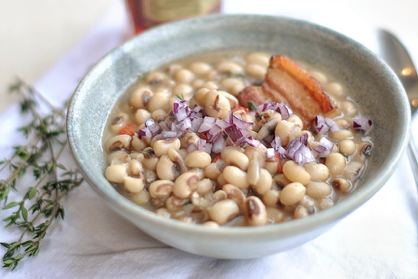
And my Aunt Annie always brought a collard greens dish to our family buffet (the greens at the table displayed our confidence for a prosperous new year). Any green will do, but collards is a southern tradition because they last so long in the garden, are affordable in the super markets, and their flavor blends nicely with ham and bacon.
Cakes and other baked goods are commonly served from Christmas to New Year's around the world, with a special emphasis placed on round or ring-shaped items. Italy has Chiacchiere, which are honey-drenched balls of pasta dough fried and dusted with powdered sugar. Poland, Hungary, and the Netherlands also eat donuts, and Holland has Ollie Bollen, puffy, donut-like pastries filled with apples, raisins, and currants.
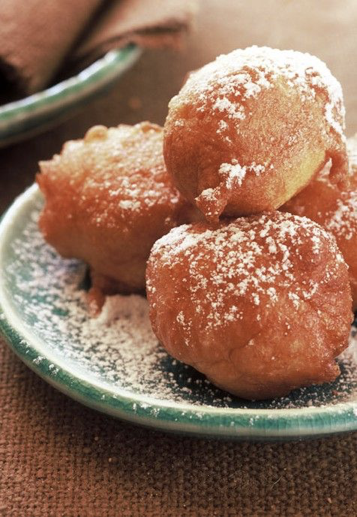
In certain cultures, it's customary to hide a special trinket or coin inside the cake—the recipient will be lucky in the new year. For instance, Mexico's Rosca de Reyes is a ring-shaped cake decorated with candied fruit and baked with one or more surprises inside.
Greece is another country where this tradition is practiced. They make a special round cake called Vasilopita and it’s always baked with a coin hidden inside. At midnight or after the New Year's Day meal, the cake is cut, with the first piece going to St. Basil and the rest being distributed to guests in order of age.
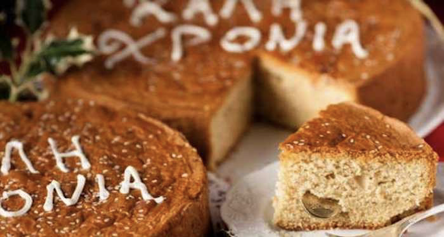
It seems the important and consistent tradition with a New Year’s cake is including something in the batter—a coin, a nut, fruits, etc. But something healthy can also be hidden in cake batter. A prune, for instance. The prune cake is a common New Year’s Day dessert for certain cultures where prunes are available.
Then there’s the pomegranate, considered a symbol of fertility, prosperity, and long life. Back to Greece, it’s their tradition to hang a pomegranate in front of each household's door on Christmas Day. At midnight on New Year's Eve, the person with good luck (the one who ended up with the coin in his or her cake) gets to smash the fruit in front of, or on the door. The number of seeds revealed indicates the amount of good luck all members of the house will experience in the months to come. Tip: Place the pomegranate in foil or a couple doubled-up plastic bags before smashing to prevent a sticky mess.
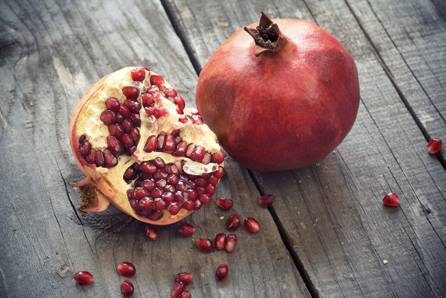
Just as it’s important to know what to eat on New Year’s Day, it’s also wise to know what not to eat. In addition to the aforementioned lucky foods, there are also a few to avoid:
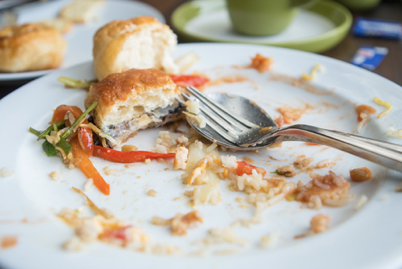
If you’d like to entice some luck, health, prosperity, and happiness into your New Year, here’s a recipe that incorporates the pomegranate seeds mentioned above. Once it’s smashed, here’s a delicious way to use them.
Finally, I want to not just say “Happy New Year!”, but thank you for being part of our DVO family. It’s a true privilege researching and writing for you! So here’s to a tasty, healthy, and creative 2020 cooking experience!

2 cups flour
2/3 cup sugar
1 tablespoon baking powder
1/2 teaspoon salt
1/4 cup minced, crystallized ginger
2 teaspoons grated lemon peels
1 1/4 cups pomegranate seeds
1 cup milk
1 large egg
1/4 cup melted and cooled butter
Directions:
Add Recipe to Cook'n

And my Aunt Annie always brought a collard greens dish to our family buffet (the greens at the table displayed our confidence for a prosperous new year). Any green will do, but collards is a southern tradition because they last so long in the garden, are affordable in the super markets, and their flavor blends nicely with ham and bacon.
Cakes and other baked goods are commonly served from Christmas to New Year's around the world, with a special emphasis placed on round or ring-shaped items. Italy has Chiacchiere, which are honey-drenched balls of pasta dough fried and dusted with powdered sugar. Poland, Hungary, and the Netherlands also eat donuts, and Holland has Ollie Bollen, puffy, donut-like pastries filled with apples, raisins, and currants.

In certain cultures, it's customary to hide a special trinket or coin inside the cake—the recipient will be lucky in the new year. For instance, Mexico's Rosca de Reyes is a ring-shaped cake decorated with candied fruit and baked with one or more surprises inside.
Greece is another country where this tradition is practiced. They make a special round cake called Vasilopita and it’s always baked with a coin hidden inside. At midnight or after the New Year's Day meal, the cake is cut, with the first piece going to St. Basil and the rest being distributed to guests in order of age.

It seems the important and consistent tradition with a New Year’s cake is including something in the batter—a coin, a nut, fruits, etc. But something healthy can also be hidden in cake batter. A prune, for instance. The prune cake is a common New Year’s Day dessert for certain cultures where prunes are available.
Then there’s the pomegranate, considered a symbol of fertility, prosperity, and long life. Back to Greece, it’s their tradition to hang a pomegranate in front of each household's door on Christmas Day. At midnight on New Year's Eve, the person with good luck (the one who ended up with the coin in his or her cake) gets to smash the fruit in front of, or on the door. The number of seeds revealed indicates the amount of good luck all members of the house will experience in the months to come. Tip: Place the pomegranate in foil or a couple doubled-up plastic bags before smashing to prevent a sticky mess.

Just as it’s important to know what to eat on New Year’s Day, it’s also wise to know what not to eat. In addition to the aforementioned lucky foods, there are also a few to avoid:
- Lobster, for instance, is a bad idea because they move backwards and could therefore lead to setbacks.
- Chicken is also discouraged because the bird scratches backwards, which could cause regret or dwelling on the past.
- Any winged fowl because good luck could fly away.

If you’d like to entice some luck, health, prosperity, and happiness into your New Year, here’s a recipe that incorporates the pomegranate seeds mentioned above. Once it’s smashed, here’s a delicious way to use them.
Finally, I want to not just say “Happy New Year!”, but thank you for being part of our DVO family. It’s a true privilege researching and writing for you! So here’s to a tasty, healthy, and creative 2020 cooking experience!

Pomegranate Ginger Muffins
Yield: 12 large or 24 medium muffins
Ingredients:
2 cups flour
2/3 cup sugar
1 tablespoon baking powder
1/2 teaspoon salt
1/4 cup minced, crystallized ginger
2 teaspoons grated lemon peels
1 1/4 cups pomegranate seeds
1 cup milk
1 large egg
1/4 cup melted and cooled butter
Directions:
1. In a bowl, mix flour, sugar, baking powder, and salt.
2. Stir in crystallized ginger, lemon peel, and pomegranate seeds. Make a well in the center.
3. In a measuring cup, blend milk, egg, and butter. Pour liquid all at once into well.
4. Stir just until batter is moistened; it will be lumpy.
5. Spoon batter into 12 (2-1/2-inch-wide) or 24 (1-3/4-inch-wide) buttered muffin cups, filling each almost to the rim.
6. Sprinkle with 1 to 2 teaspoons sugar.
7. Bake at 425 degrees until lightly browned (about 16 minutes for large muffins, 13 minutes for small).
8. Remove muffins from pan at once.
2. Stir in crystallized ginger, lemon peel, and pomegranate seeds. Make a well in the center.
3. In a measuring cup, blend milk, egg, and butter. Pour liquid all at once into well.
4. Stir just until batter is moistened; it will be lumpy.
5. Spoon batter into 12 (2-1/2-inch-wide) or 24 (1-3/4-inch-wide) buttered muffin cups, filling each almost to the rim.
6. Sprinkle with 1 to 2 teaspoons sugar.
7. Bake at 425 degrees until lightly browned (about 16 minutes for large muffins, 13 minutes for small).
8. Remove muffins from pan at once.
Recipe formatted with the Cook'n Recipe Software from DVO Enterprises.
Sources:
- www.tastykitchen.com
- www.greece.greekreporter.com
- www.greekboston.com
- www.theappetitedoctor.co.uk
- www.pinterest.com
 Alice Osborne
Alice Osborne
Weekly Newsletter Contributor since 2006
Email the author! alice@dvo.com
